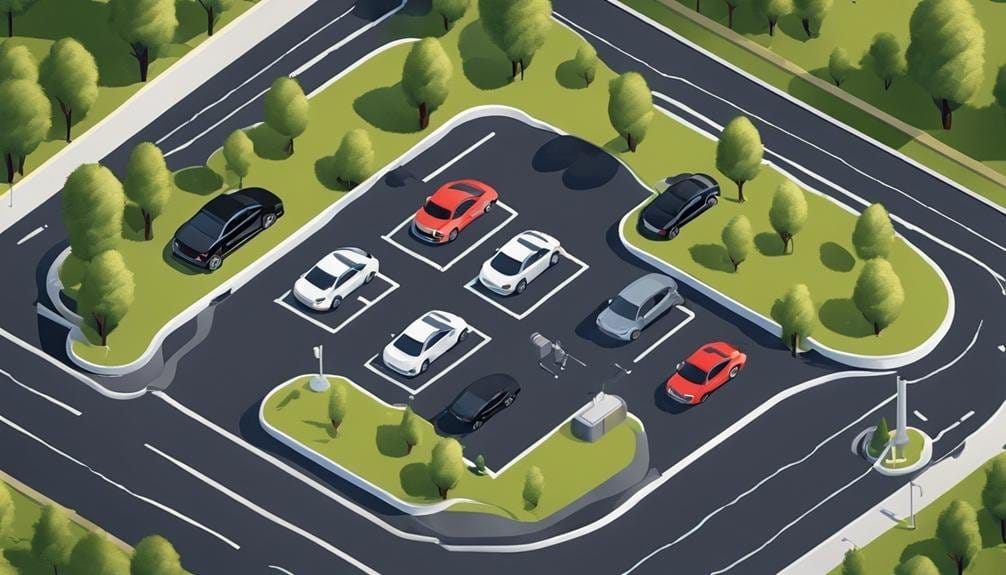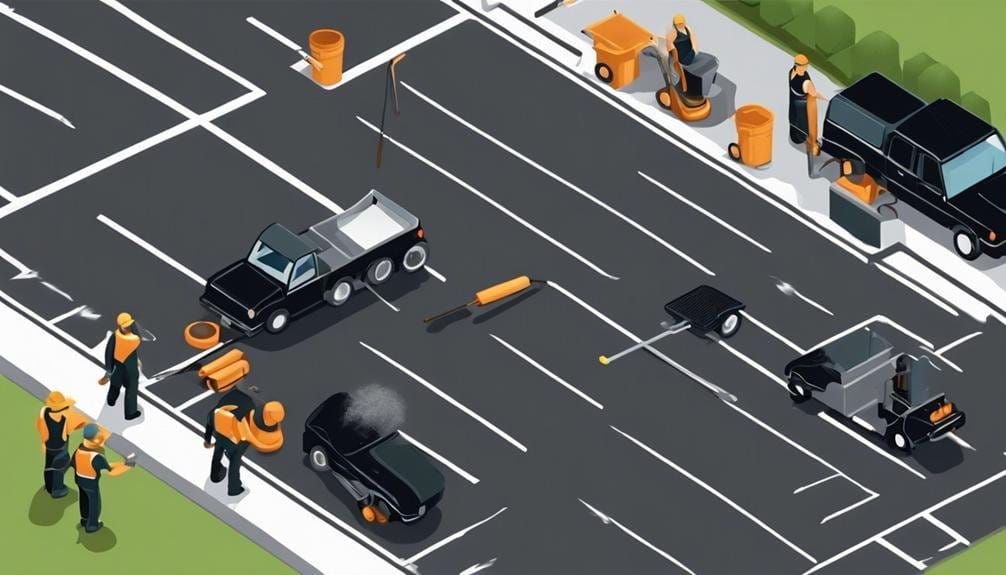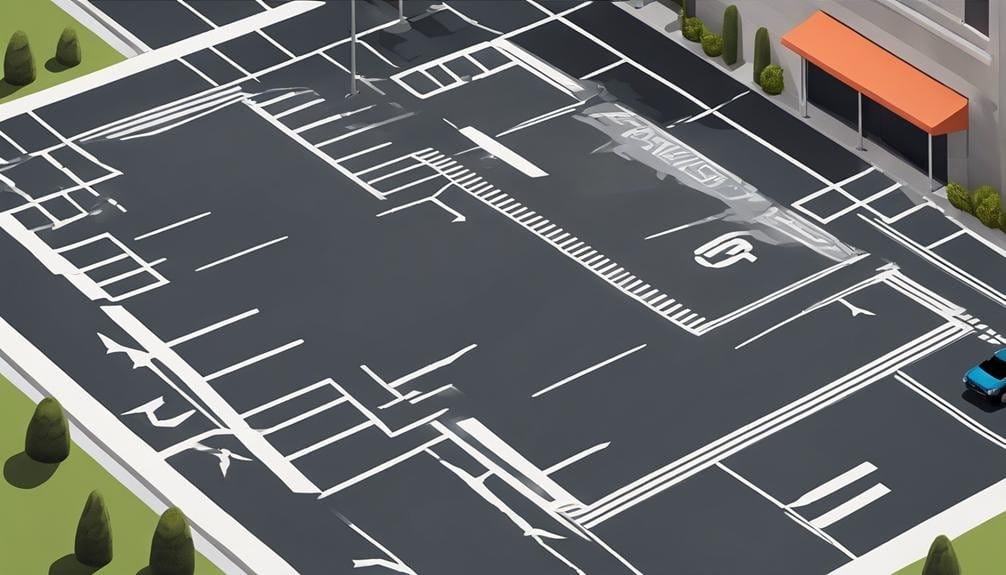When it comes to sealing a parking lot, you may not realize the critical steps involved in ensuring a durable and long-lasting finish. From proper surface preparation to selecting the right sealant, each stage plays a vital role in the overall effectiveness of the sealing process.
But what about the lesser-known factors that can make a significant difference in the outcome? Stay tuned to discover the often overlooked tips that could make or break your parking lot sealing project.
Key Takeaways
- Sealcoating protects against sun damage, water intrusion, and chemical deterioration.
- Proper preparation and application ensure a lasting sealcoat and enhance pavement longevity.
- Pavement markings must adhere to specifications for safety and visibility post-sealcoating.
- Regular resealing is a cost-effective strategy to preserve the parking lot and extend its lifespan.
Benefits of Sealcoating

Sealcoating provides essential protection for parking lot pavement by forming a durable barrier against sun damage, water intrusion, and chemical deterioration. Parking lot maintenance is crucial for preserving the integrity of the asphalt surface. Sealcoating acts as a shield, safeguarding the asphalt pavement from the harsh elements it faces daily. By applying a sealcoat regularly, you ensure that your parking lot remains in top condition, extending its lifespan and reducing the need for costly repairs.
Preserving the asphalt surface through sealcoating not only protects it from environmental factors such as UV rays and water but also enhances its appearance. The fresh, dark finish achieved by sealcoating covers small cracks and imperfections, providing a smooth and uniform look to your parking lot. This process significantly boosts the curb appeal of your property, leaving a lasting impression on visitors and customers.
In locations like Florida with hot climates, sealcoating is especially vital to combat sun damage and maintain the overall durability of the pavement. By investing in regular sealcoating as part of your parking lot maintenance routine, you save money in the long run by avoiding more extensive repairs like asphalt paving.
Conditions for Long-Lasting Sealcoats
Under optimal weather conditions, achieving a long-lasting sealcoat on asphalt pavements necessitates meticulous attention to specific environmental factors. Ideal sealcoating conditions involve warm, sunny days with low humidity to ensure optimal results. High humidity and cool weather can significantly delay the curing time of the sealcoat, affecting its overall durability and performance. Additionally, rain during the sealcoating process can dilute the asphalt binder, potentially leading to issues with the sealcoat’s adhesion and effectiveness.
It is crucial to avoid applying sealcoating to pavements with significant damage or load-related distress, as this can compromise the integrity of the sealcoat. Pavements in good condition, with low friction numbers, are best suited for long-lasting sealcoats. Ensuring that the weather conditions are favorable and that the pavement is in good condition before sealcoating can help maximize the longevity and effectiveness of the sealcoat on your parking lot.
Materials for Sealcoat

To ensure the longevity and effectiveness of your sealcoat, selecting the appropriate materials is crucial for protecting and preserving asphalt surfaces. Two primary materials commonly used for sealcoating are asphalt emulsion and coal tar sealers. Asphalt emulsion-based coatings are gaining popularity due to their ease of application and lower odor compared to coal tar sealers. However, refined coal tar emulsion remains a prevalent choice because of its stability against varying weather conditions, making it a durable option for pavement maintenance. Both materials play a vital role in maintaining the surface integrity of asphalt and preventing the development of cracks. Proper selection of sealcoat materials is essential for effective protection and preservation of asphalt surfaces.
| Materials | Advantages | Disadvantages |
|---|---|---|
| Asphalt Emulsion | Easy application, lower odor, gaining acceptance | May not be as weather-resistant |
| Coal Tar Sealers | Stable against weather, durable choice for sealcoating | Strong odor, environmental concerns |
Asphalt Pavement Preparation
For optimal results in sealing a parking lot, meticulous preparation of the asphalt pavement is essential to ensure proper adhesion and longevity of the sealcoat. Here’s how to prepare the pavement surface effectively:
- Clear Debris: Before sealcoating, it’s crucial to clear the pavement surface of any weeds, loose asphalt, or other debris. This ensures a smooth and uniform sealcoat application.
- Thorough Cleaning: Cleaning the entire pavement surface with a diluted driveway cleaner is vital. This step helps remove dirt, oil film, and other contaminants that can hinder the adhesion of the sealant.
- Priming if Necessary: Older, oxidized pavement may require priming before sealcoating to promote better adhesion. Priming prepares the surface for the sealcoat, especially in cases where the pavement has deteriorated over time.
Application of Sealcoating

After meticulously preparing the asphalt pavement, the next crucial step in the maintenance process is applying the sealcoating to ensure optimal protection and longevity of the parking lot surface.
When it comes to sealant application, timing and temperature are key factors. It’s recommended to apply sealcoating during warm and dry weather conditions with temperatures of at least 60°F for the best results.
Before applying the sealant, make sure the pavement is clean and primed properly to promote adhesion and enhance longevity. For older asphalt surfaces, consider applying multiple coats of sealant to provide increased protection and durability.
When selecting a sealant product, opt for one that contains sand to improve skid resistance and traction on the pavement. Additionally, ensure that the pavement temperature is above 40°F during application for proper drying and effectiveness.
Following these guidelines will help maintain and protect your parking lot surface effectively.
Mixing the Sealer
Ensure proper consistency of the sealer by meticulously following the manufacturer’s instructions for mixing. To achieve an effective sealcoating application, the sealer must be mixed correctly. Here’s how to do it:
- Follow Manufacturer’s Instructions: The manufacturer provides specific guidelines for mixing the sealer. It’s crucial to adhere to these instructions to ensure the right consistency for optimal performance.
- Utilize Mechanical Mixer or Agitator: Use a mechanical mixer or agitator to blend the sealer thoroughly and evenly. This ensures that all components are properly mixed, preventing any inconsistencies in the application.
- Avoid Dilution: Refrain from diluting the sealer with water or other substances as this can impact its performance. Maintaining the original consistency of the sealer is key to achieving a uniform application and maximizing the benefits of sealcoating.
Sealcoating Process

To properly execute the sealcoating process for a parking lot, start by thoroughly cleaning the surface to ensure optimal adhesion of the sealant. Remove all dirt, debris, and vegetation using a power blower, broom, or pressure washer. Fill any existing cracks with crack filler before applying the sealcoat to create a smooth surface. Carefully inspect the entire area for any potential issues that may affect the sealant’s application.
Once the surface is clean and prepped, begin the sealcoating application. Use a squeegee, brush, or spray system to evenly spread the sealant across the parking lot surface. Work methodically to ensure complete coverage and a consistent thickness. Pay special attention to high-traffic areas that may require additional layers for added protection.
Allow the sealant to dry properly between coats as per manufacturer instructions. Typically, this process involves waiting for the first coat to cure before applying a second coat. Proper drying time is crucial for the sealant to bond effectively with the surface, ensuring long-lasting protection and maintenance benefits.
Bidding Considerations
When preparing a bid for a parking lot sealcoating project, assess the size and condition of the lot to determine the scope of work required. Consider the following key points:
- Parking Lot Evaluation: Carefully inspect the entire parking lot to identify areas that may need special attention, such as cracks, potholes, or oil stains. Assess the layout of the lot, including any intricate features like islands or medians, which may affect the application of the sealer.
- Pavement Markings: Take note of existing pavement markings such as parking lines, handicap symbols, or directional arrows. Determine if these markings need to be preserved or if new markings will be required after the sealcoating process.
- Coats of Sealer: Based on the condition of the pavement and client preferences, decide on the number of coats of sealer needed. Consider factors like traffic volume, weather conditions, and the desired longevity of the sealcoating.
Striping Specifications

Utilize standardized measurements and reflective paint for clear delineation of parking spaces in accordance with striping specifications. When striping a parking lot surface, it’s crucial to adhere to the standard parking stall dimensions of 9 feet in width and 18 feet in length. Handicap parking spaces require a minimum width of 8 feet, accompanied by an adjacent access aisle to ensure accessibility. Fire lanes, essential for emergency access, must be at least 20 feet wide and be clearly marked with appropriate signage.
To meet striping specifications effectively, it’s recommended to use reflective paint. This type of paint enhances visibility, especially during nighttime or low-light conditions, increasing safety for drivers and pedestrians alike. When painting lines for parking stalls, ensure they’re 4 inches wide and 15 feet in length for standard spaces. Following these guidelines meticulously won’t only provide a professional appearance but also contribute to the efficient organization of the parking lot.
Parking Lot Resealing Importance
Ensuring the longevity and structural integrity of a parking lot necessitates regular resealing every three years as recommended by industry professionals. Proper maintenance is crucial for preserving the pavement and extending its lifespan. Here are three key reasons emphasizing the importance of resealing:
- Protection from Oxidation: Resealing forms a protective barrier that shields the parking lot from oxidation caused by exposure to air and sunlight. This helps prevent premature deterioration of the asphalt surface.
- Prevention of Water Intrusion: Resealing helps waterproof the pavement, preventing water from seeping into cracks and causing damage to the underlying layers. This is essential for maintaining the stability and strength of the parking lot.
- Erosion Mitigation: Rainfall can accelerate erosion of the base layers of the parking lot, compromising its structural integrity. Timely resealing acts as a preventive measure against erosion, ensuring the longevity of the parking lot.
Regular maintenance is a cost-effective strategy to avoid extensive repairs and keep the parking lot in optimal condition.
Conclusion
In conclusion, sealcoating your parking lot is essential for protecting it from wear and tear, extending its lifespan, and maintaining its appearance.
By following proper preparation techniques, using the right materials, and applying multiple coats, you can ensure a long-lasting and durable sealcoat.
Remember, a well-sealed parking lot is like a suit of armor for your pavement, ready to withstand the elements and daily traffic.
